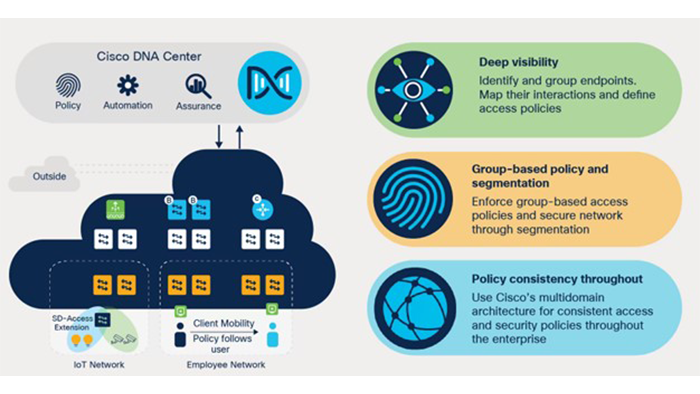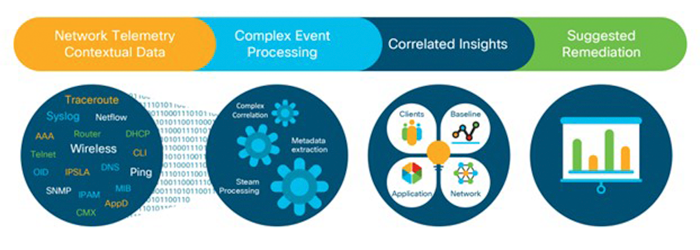Cisco Software-defined access, also known as Cisco SD Access, uses SDN’s guiding principles to apply them to the network’s access edge. Instead of managing each access switch as a separate entity, SD-access places the access edge under the control of a centralized network controller.
Pushing fine-grain network access control to the edge is what SD-access aims to achieve. The desire for increased network security is the primary motivator for enterprise SD-access adoption. The main goal of the licensed Cisco SD-access is to tighten security controls on who and what can connect, as well as determine what connected entities can do. This is true even though SDN-style centralized management can control all aspects of edge switch behavior.
Using Cisco DNA Center all clients can be assured that every single process can be handled automatically based on pre-defined policies.

Because of manual configuration and a fragmented tool offering, managing the network today is very difficult. Manual processes are laborious and prone to mistakes. The environment is constantly changing, which makes problems worse. It is more difficult to configure and maintain a consistent user policy across the network due to the increase in users and variety of device types.
Due to timing constraints and the need to coordinate with various infrastructure groups, setting up or deploying a single network switch can take several hours. Deploying a group of switches can occasionally take a few weeks.
Modern network management must include security as a key element. In order to effectively adapt to changing circumstances, organizations must safeguard their resources. Tracking VLANs, access control lists (ACLs), and IP addresses in conventional networks can be difficult to do in order to maintain the highest level of policy and security compliance.
Because different departments manage different systems, disparate networks are typical in many organizations. Building management systems, security systems, and other production systems are typically operated independently from the main IT network. As a result, management procedures become inconsistent and redundant network hardware purchases are made.
IT teams frequently struggle with out-of-date tools for change management, maintaining productivity, and resolving issues quickly.
The licensed Cisco SD-Access offers next-generation capabilities by facilitating policy-based automation from the edge to the cloud. These consist of:

The three components below are connected by the licensed Cisco SD-access:
The behavioral threat analytics tool makes the SD-access network behavior-aware, which is necessary for implementing an SDP or ZTNA. It has the ability to recognize unusual behavior and alert the policy engine when it occurs, such as behavior linked to attacks or compromised systems. After that, the policy engine can give the edge network instructions to deny, quarantine, or limit access for the associated entity or identity.
One strategy for zero trust is SD-access. Businesses interested in implementing zero trust at the network access edge should compare SD-access to alternative solutions like SDP. They should also think about putting ZTNA into practice as soon as resources allow.
Using Cisco DNAC, when instructed by a centralized policy engine, edge switches apply ACLs and assign ports to VLANs. Edge switches, which are the heart of an SD-access system, are what enable but do not mandate SD-access to implement zero trust. A wide variety of security environments can be created using the access policies. These can be completely open, requiring no kind of authorization, all the way to fully zero trust, preventing any access that isn’t expressly authorized.
The licensed Cisco SD-access access control component is provided by edge switches. They enforce initial system identity authentication as well as any subsequent reauthentication after initial admission. They also apply access control lists (ACLs) and virtual LANs (VLANs) to each port, limiting the areas of the network that port can access. These assignments are essentially static in a conventional network, but dynamic in an SD-access network and subject to change at any time.
These assignments may alter as a result of policy changes. Such modifications take effect right away, and systems reauthenticate and reauthorize. It is possible to block a system’s port or assign it to a quarantine VLAN when it misbehaves and needs to be isolated from other systems.
Unlike both authenticated network access and NAC, Cisco DNAC aims to integrate this broader and finer-grained control into the core of network operations. Because Cisco SD-Access gives network teams a platform to use, they can make sure a system behaves appropriately not only during admission but also during each subsequent interaction. This means SD-Access is in line with current goals for a zero-trust network. The network need not regain its previous level of trust in a system when using the licensed Cisco SD-access. A software-defined perimeter (SDP) or zero-trust network access (ZTNA) can be used in an SD-Access network.
As opposed to authenticated network access, comprehensive network access control (NAC) systems go much further. NAC performs health checks on endpoints to check for indications of compromise or security policy noncompliance. Some NAC systems can also keep an eye on how the network is being used for any unusual behaviors, like a node trying to access areas of the network that it is not allowed to. In the event that a system misbehaves, NAC systems also have mechanisms to block access to the network.
More advanced than traditional authenticated network access is SD-Access. When using authenticated network access, which is Ethernet’s IEEE 802.1x standard, a system connected to a protected port can initially only communicate with the edge switch to which it is connected. It is unable to communicate with other network devices, including ports on the same switch.
The enterprise directory is typically required for system authentication when using the edge switch. The switch will deny access to the network past the port to which it is connected if the system cannot provide an identity authorized to use the network. Although authenticated access is an improvement over open access, the network edge is not completely protected. When entering the network for the first time, authenticated access only performs an identity analysis and a single check.
In conclusion, Cisco SD-Access can offer the following advantages:
| Name | Description | Official Price | Our Price |
|---|---|---|---|
| L-EP-ENSDA-D11= | Deploying Cisco SD-Access v1.1. | Contact Us | -- |
| L-NW-SDUPD-DL12= | SD-Access 1.2 Update Supplement A-SDA-12UPDT). | Contact Us | -- |
| L-NW-CUSDAFND-D1= | Planning and Deploying SD-Access Fund. (CUST-SDA-FUND) v1.0. | Contact Us | -- |
| L-NW-CUSDAISE-D1= | Preparing the ISE for SD-Access (CUST-SDA-ISE) v1.0. | Contact Us | -- |
| L-CTOD-SDAFUND= | Planning and Deploying SD-Access Fundamentals (Customers). | Contact Us | -- |
| L-CTOD-SDAISE= | Preparing the Identity Services Engine (ISE) for SD-Access. | Contact Us | -- |